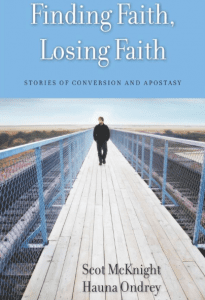 This piece fascinated me for one significant reason: I did research one time on why evangelicals leave the church, or abandon their faith, and along with Hauna Ondrey, published it in a study of how various conversions occur — find the study of apostasy in Finding Faith, Losing Faith.
This piece fascinated me for one significant reason: I did research one time on why evangelicals leave the church, or abandon their faith, and along with Hauna Ondrey, published it in a study of how various conversions occur — find the study of apostasy in Finding Faith, Losing Faith.
I read hundreds of stories, and not one had anything to do with sexual abuse. Now we learn that 10% of 35 and unders have left church over this issue and 5% of all churchgoers have left over sexual abuse issues.
My study was not a scientific or sociologically based study with all the stats and variations and permutations, but I read lots and lots of stories that I found, plus I read a number of books on the topic.
So, what to think? First, the MeToo and ChurchToo movements have brought this to the fore and especially the victims very well may walk from the faith. Family members of such persons too. Second, churches and church leaders did not bring this to the fore: activists on social media did. That alone cut a deep gash in church credibility. Third, this new study reported by Shellnutt demonstrates once again that sexual abuse is awful, it is too common, it victimizes innocent people, those people are further victimized by denials and spinning stories told by leaders and churches, and sexual abuse destroys the witness and credibility of gospel and church.
From Kate Shellnutt’s report in CT:
According to a new study sponsored by LifeWay Christian Resources, 10 percent of Protestant churchgoers under 35 have previously left a church because they felt sexual misconduct was not taken seriously. That’s twice as many as the 5 percent of all churchgoers who have done the same.
Among the younger demographic, 9 percent said they have stopped attending a former congregation because they personally did not feel safe from misconduct.
Churchgoers ages 18 to 34 are more likely than older generations to report experiencing sexual harassment—ranging from sexual comments and prolonged glances—at church and to know others at their church who are victims (23%).
“It is not surprising that young adults who have only known this frank ‘call it what it is’ sexual culture to be more likely to identify instances of misconduct than older adults,” Scott McConnell, executive director of LifeWay Research which conducted the survey, told CT.
Another factor: Younger churchgoers are also closest to the ages when most sexual assault takes place. The highest risk spans ages 12 to 34, peaking between 16 and 19, according to Justin Holcomb, an expert on sexual abuse in the church and a board member of GRACE (Godly Response to Abuse in the Christian Environment).
While 14 percent of those ages 18 to 34 say that sexual advances from people at church have led them to attend less frequently, just 1 percent of those over 65 said the same. The youngest generation is two to three times more likely than the oldest generation to say they have experienced sexual harassment in the form of sexualized compliments and jokes, sexting, or prolonged glances.











